
Early 15th century Belt with pewter fittings
Jack Banyard
The main inspiration for this belt, comes from a tomb effigy of a knight in the temple church of St. Mary, London, that shows both bars and other mounts from the mid 13th century. It is not until towards the 1300's that we see a wider verity of mounts made from lead/tin. Examples of T shaped belt ends made from lead/tin have been found in London after 1350. Buckles made from lead/tin are seen from the 1400's and after. Before the 1300's most mounts and buckles are either a copper alloy or iron.
|
There have been finds of mounts with pewter since 1150, but pewter was not commonly used outside of mounts until around the 1350's. This had to do with the London Girdlers' Guild.s restriction of non-ferrous white metals for strap accessories until the late 14th century. Very few excavated strap fittings predate the London Girdlers' guild charter of 1321. Fittings made from lead, pewter, tin were considered "False work", and if local officials or searchers sent from London found 'false work...they shall be burned'. In the guild articles of 1344, again reinforced the ban on the growing use of inferior metals and alloys on girdles. It wasn't until 1391 do we see the guild recognize these white metals, and ease their restrictions. By the 1400.s, with the ease of restrictions, pewter was being use in place of silver and other metals in belt fittings.
In period pewter the portions lead and tin varied widely. The amount of lead could range from just 10% lead, or up to 90% lead. All of these pieces where made with a lead free alloy, that is sometimes called Britannia. It contains 92.5% tin, 6% Antimony, 1.5% Copper and behaves slimily to pewter for our use.
I had commissioned belt itself for piece that I had made to be placed on.
Belts were available in a leather or woven from threads of silk, linen or worsted. From sumptuary law of 1363 (statute 37 Ed.III c8-14), it is implied that linen belts were among the cheapest available, since it is references linen girdles for ploughmen. Woven belts were tablet woven; though I would have liked to have had it done in silk, but because of cost I had it made from cotton which is easily available today and is not expensive.
Widths of the belt varies greatly, from looking at belt ends, buckles and mounts we can see widths ranging from just a 1/2 of an inch to and 1 and a half. We can even see that some belts are no wider then the widest width of a finger, and this is were we got our 3/4 of inch for the width of this belt. For length again, there is no set length for belts. Again after looking at illuminations and effigies, and trying different lengths, I decided that the length I like the best was about a hand span up from the knee.
|
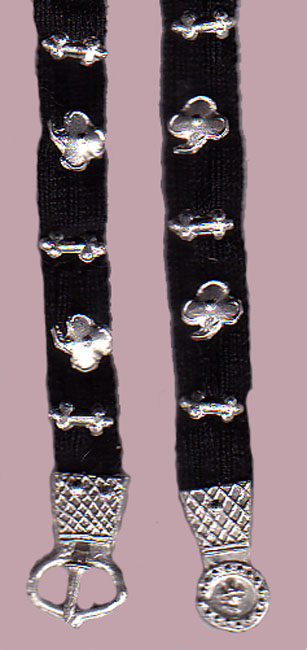
|
The Belt End
A common theme though at all aspects of this project, is the wide variety of fitting, even with the pewter ones. Pewter belt ends range from plates to roundels that are either directly on the belt, or having the roundel hanging from the belt on a plate that connects to the belt. Commonly the belt ends were riveted to the belt. Belt ends were usually attached to the belt, either by making a pocket that the belt slides into, or a belt end with a fork attached providing a space that the belt slides into with plates that were then riveted and tined to form the pocket that wraps the belt. By 1350 in London finds, we start seeing T-shape belt end. This type of belt end has the top bar of the T visible belt end and then the leg is bent over the belt and riveted to the top bar. A common design of casted T-shape belt ends is cross-hatching on the upper part of the front. On the round part designs vary from an open work decoration with a beaded boarder to a solid roundel with some type of flower with a beaded boarder.
For my belt I have decided to keep the cross-hatched top with a two-line divide before the roundel. I chose a trefoil since this will be a common unifying theme running though out the project. The trefoil will be on a solid base with a beaded border. The mold for this is a three-piece mold, two pieces form the tab that bends over and the third the belt end front.
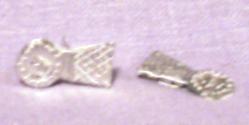
|
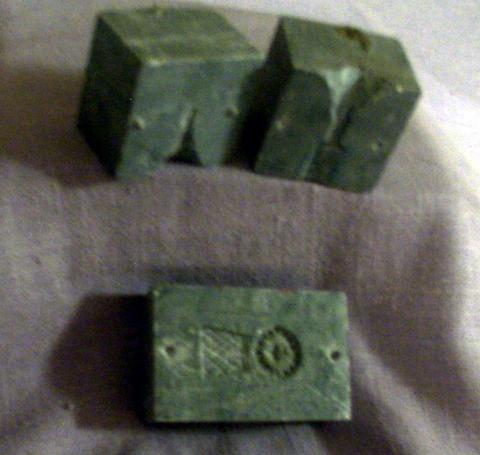
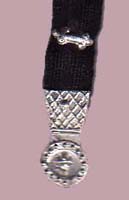
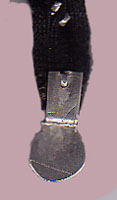
|
The Mounts
Though most bar mounts are simple plain mounts usually made from copper alloy; there are some examples of pewter bar mounts. The styling of bar mounts range from a simple bar that's a rectangle to a bar with terminal lobes (some times with a central lobe too), or an arrow. The original idea was to have a bar with lobes on both ends, but since the other mount would be a trefoil I decided to put three lobes on the ends to carry the them of the other mount and belt end. The other choice to be made was how to attach the bar mounts to the belt. The two choices that are commonly used were either external rivets or using integral rivets. Though there are more examples of the first I decided to use integral rivets. The mold for this is shared with the trefoil mount; the two sides form the shank and the third the face.
Flowers are a common motif found as mounts with integral rivets. Though the most common motifs are heraldic roses (both 5 sided and six sided), there are also quatrefoils, cinquefoils, sexfoils, and septfoils. I decided to use a trefoil since I have a trefoil on my device even though it was not as common as some other motifs. The Mold for this is on the same three-piece mold as the bar mounts.

|

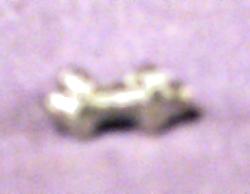
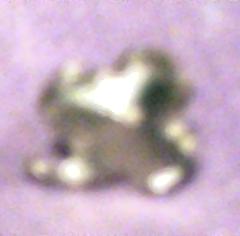
|
The Buckle
The majorities of buckles found in London, are of copper alloy, and were usually coated with tin. We don't start seeing pewter buckles until the early 1400's because of the attempts of the London Girder Guild to outlaw fittings of what they considered inferior metals. Of those pewter buckles found, the frame is formed by alternating between a cross-hatched convex and plain concave roundels, the plate part of the buckle has a plant motif on a cross-hatched field; two domed-headed rivets to hold to the belt.
For my belt, I decided to leave the just a crosshatched field on the plate over the belt, to match the belt end. But for the frame of the loop, I went back to an earlier simple oval frame that was common with the copper alloy buckle, and a casted pin. The mold for the buckle, is just a registered two-part mold.
|
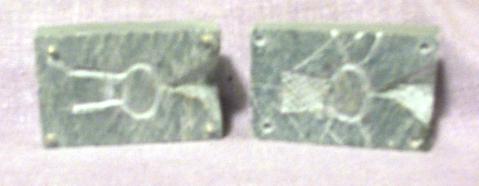
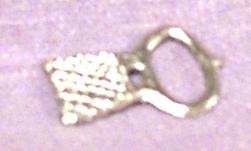
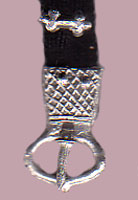
|
Bibliography:
The Museum of London: Dress accessories ~ ISBN 0 11 290444 0
Medieval Artefacts ~ Nigel Mills

Home
| 













